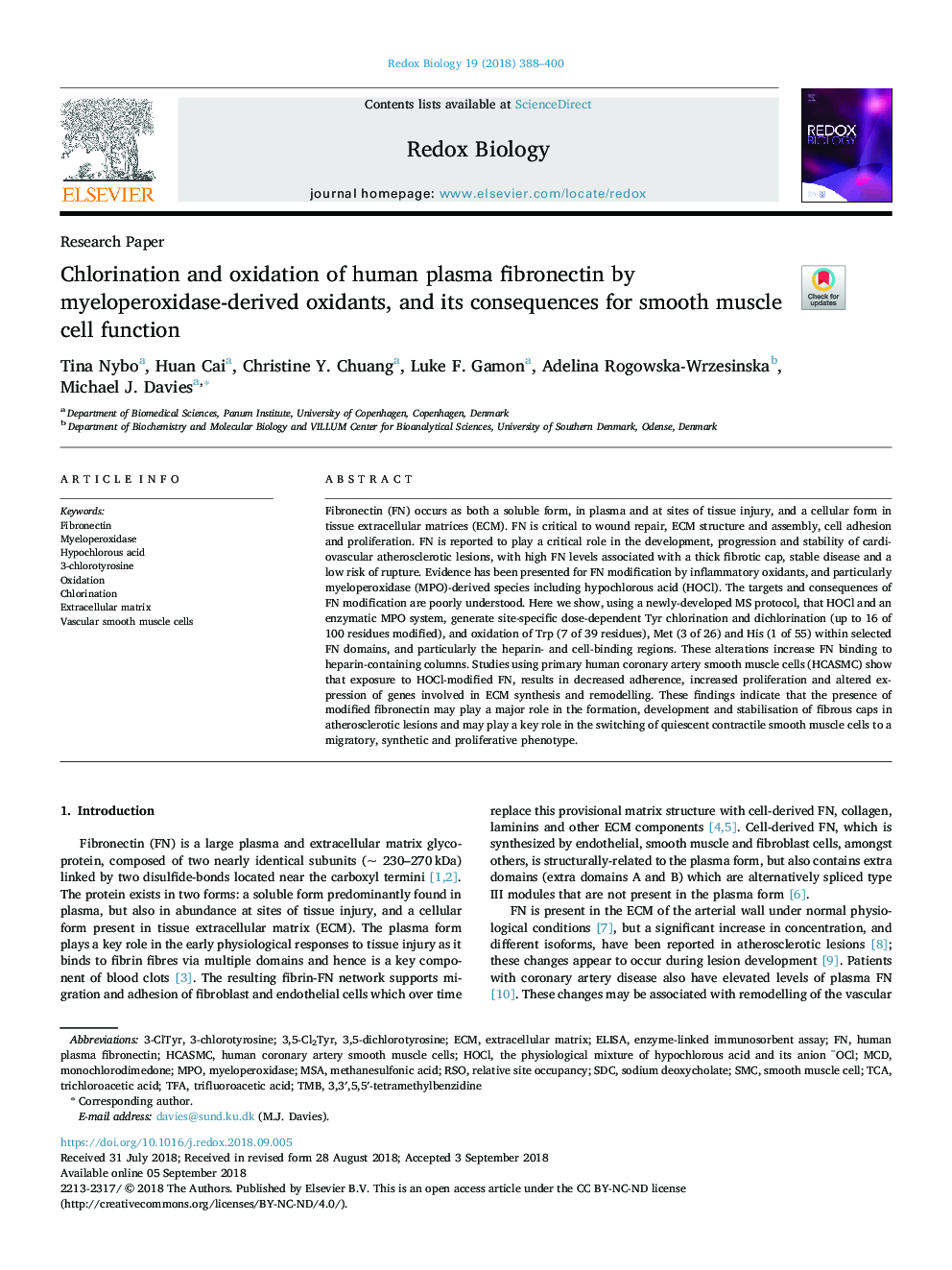| کد مقاله | کد نشریه | سال انتشار | مقاله انگلیسی | نسخه تمام متن |
|---|---|---|---|---|
| 9954068 | 1535831 | 2018 | 13 صفحه PDF | دانلود رایگان |
عنوان انگلیسی مقاله ISI
Chlorination and oxidation of human plasma fibronectin by myeloperoxidase-derived oxidants, and its consequences for smooth muscle cell function
ترجمه فارسی عنوان
کلرزنی و اکسیداسیون فیبرنکتین پلاسمای انسانی توسط اکسنده های مینرالکسیداز و پیامدهای آن برای عملکرد سلول های عضلانی صاف
دانلود مقاله + سفارش ترجمه
دانلود مقاله ISI انگلیسی
رایگان برای ایرانیان
کلمات کلیدی
TCAHOClECMTFASDCMSATMBMCDRSOSMCHuman plasma fibronectinhCASMC3,5-dichlorotyrosine3-chlorotyrosine - 3-کلروتیروسین3,3′,5,5′-tetramethylbenzidine - 3،3 '، 5،5'-تترامیلیل بنزیدینMPO - DFOTrifluoroacetic acid - اسید Trifluoroacetictrichloroacetic acid - اسید ترشکلراکتیکMethanesulfonic acid - اسید متان سولفونیکhypochlorous acid - اسید هیپوکلریدهOxidation - اکسیداسیونEnzyme-linked immunosorbent assay - تست الیزاELISA - تست الیزاSodium deoxycholate - سدیم دگزیکسولاتSmooth muscle cell - سلول عضلانی صافVascular smooth muscle cells - سلول های عضلانی صاف عروقیhuman coronary artery smooth muscle cells - سلول های عضلانی عروق کرونر انسانی انسانFibronectin - فیبرونکتینExtracellular matrix - ماتریکس خارج سلولیMonochlorodimedone - مونوکلردیدیدونmyeloperoxidase - میلوپراکسیداز Chlorination - کلرزنی
موضوعات مرتبط
علوم زیستی و بیوفناوری
بیوشیمی، ژنتیک و زیست شناسی مولکولی
سالمندی
چکیده انگلیسی
Fibronectin (FN) occurs as both a soluble form, in plasma and at sites of tissue injury, and a cellular form in tissue extracellular matrices (ECM). FN is critical to wound repair, ECM structure and assembly, cell adhesion and proliferation. FN is reported to play a critical role in the development, progression and stability of cardiovascular atherosclerotic lesions, with high FN levels associated with a thick fibrotic cap, stable disease and a low risk of rupture. Evidence has been presented for FN modification by inflammatory oxidants, and particularly myeloperoxidase (MPO)-derived species including hypochlorous acid (HOCl). The targets and consequences of FN modification are poorly understood. Here we show, using a newly-developed MS protocol, that HOCl and an enzymatic MPO system, generate site-specific dose-dependent Tyr chlorination and dichlorination (up to 16 of 100 residues modified), and oxidation of Trp (7 of 39 residues), Met (3 of 26) and His (1 of 55) within selected FN domains, and particularly the heparin- and cell-binding regions. These alterations increase FN binding to heparin-containing columns. Studies using primary human coronary artery smooth muscle cells (HCASMC) show that exposure to HOCl-modified FN, results in decreased adherence, increased proliferation and altered expression of genes involved in ECM synthesis and remodelling. These findings indicate that the presence of modified fibronectin may play a major role in the formation, development and stabilisation of fibrous caps in atherosclerotic lesions and may play a key role in the switching of quiescent contractile smooth muscle cells to a migratory, synthetic and proliferative phenotype.
ناشر
Database: Elsevier - ScienceDirect (ساینس دایرکت)
Journal: Redox Biology - Volume 19, October 2018, Pages 388-400
Journal: Redox Biology - Volume 19, October 2018, Pages 388-400
نویسندگان
Tina Nybo, Huan Cai, Christine Y. Chuang, Luke F. Gamon, Adelina Rogowska-Wrzesinska, Michael J. Davies,
